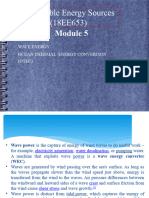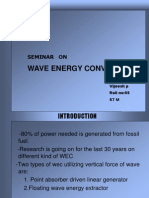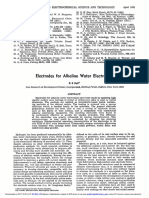Notes On Wave Power
Uploaded by
jamesfinesslNotes On Wave Power
Uploaded by
jamesfinesslWaves, as a powerful and constant natural phenomenon, can be harnessed to capture
energy through various technologies. The energy generated from waves is a form of
ocean energy, and it has the potential to contribute to sustainable and renewable
power generation. Here are some ways waves can be used to capture energy:
Wave Energy Converters (WECs):
Point Absorbers: These devices consist of floating structures tethered to
the seabed. The motion caused by the waves makes the structure move, and this
motion is converted into electricity through generators.
Attenuators: These WECs use the relative motion between different segments
of a structure to capture energy. As waves pass along the length of the device,
hydraulic pumps or other mechanisms convert the motion into electricity.
Oscillating Water Columns (OWCs): OWCs use the rise and fall of water
within a chamber to generate air movement, which then drives a turbine connected to
a generator, producing electricity.
Overtopping Devices: These devices capture water from incoming waves and
release it into a reservoir at a higher level. The potential energy from the
elevated water is then used to drive turbines and generate electricity.
Buoyancy-driven Systems:
Pelamis Wave Energy Converter: Comprising a series of linked cylindrical
sections connected by hinged joints, the Pelamis device moves with the waves. The
movement drives hydraulic motors, converting the mechanical energy into
electricity.
Linear Generators:
Linear Permanent Magnet Generators (LPMGs): These generators convert the
linear motion of wave-induced motion into electrical power. As the device moves
with the waves, magnets passing through coils induce electrical currents.
Underwater Turbines:
Tidal Stream Generators (TSGs): TSGs are similar to underwater wind
turbines but are placed in areas with strong tidal currents. The kinetic energy of
the moving water is captured by the rotating blades, generating electricity.
Wave Pumps:
Wave Pumped Storage: This concept involves using wave energy to pump water
to a higher elevation, creating potential energy. During periods of high
electricity demand, the stored water is released, flowing through turbines to
generate electricity.
Floating Platforms:
Floating Platforms with Power Take-Offs: These platforms are equipped with
power take-off systems, such as hydraulic cylinders or point absorbers, to convert
the motion induced by waves into electrical power.
Piezoelectric Materials:
Piezoelectric Generators: Piezoelectric materials can convert the
mechanical stress generated by wave motion into electrical energy. When waves cause
deformation in these materials, it induces an electric charge that can be
harvested.
Harnessing wave energy offers the advantage of providing a consistent and
predictable power source, as waves are influenced by factors such as wind patterns
and the gravitational pull of the moon. However, challenges such as the harsh
marine environment, high construction and maintenance costs, and environmental
impact assessments need to be addressed for widespread adoption of wave energy
technologies.
You might also like
- Report Submitted ON: Submitted By: Pooja Malik ROLL NO: 0804034 Branch: Mechanical (4 Year)No ratings yetReport Submitted ON: Submitted By: Pooja Malik ROLL NO: 0804034 Branch: Mechanical (4 Year)25 pages
- Ocean Wave Energy: The Energy From Waves and From TidesNo ratings yetOcean Wave Energy: The Energy From Waves and From Tides31 pages
- Huang 2020 IOP Conf. Ser. Earth Environ. Sci. 585 012004No ratings yetHuang 2020 IOP Conf. Ser. Earth Environ. Sci. 585 0120048 pages
- Technical Seminar Topic: Bachelor of Technology Electrical and Electronics EngineeringNo ratings yetTechnical Seminar Topic: Bachelor of Technology Electrical and Electronics Engineering24 pages
- Fuel and Energy Utilization Ece4433: Segi UniversityNo ratings yetFuel and Energy Utilization Ece4433: Segi University13 pages
- A Paper On Hydrokinetic Renewable Energy Sources: BY D.Arumuga SelvanNo ratings yetA Paper On Hydrokinetic Renewable Energy Sources: BY D.Arumuga Selvan9 pages
- Advancements and Improvements in Tidal Power - Docx BENZONNo ratings yetAdvancements and Improvements in Tidal Power - Docx BENZON3 pages
- Ocean Energy, Tidal Energy and Geothermal EnergyNo ratings yetOcean Energy, Tidal Energy and Geothermal Energy102 pages
- Drew, B., Plummer, A.R., Sahinkaya, M.N. A Review of Wave Energy Converter Technology. 2009 PDFNo ratings yetDrew, B., Plummer, A.R., Sahinkaya, M.N. A Review of Wave Energy Converter Technology. 2009 PDF16 pages
- Renewable Energy: Hydropower, Tidal Power and Wave PowerNo ratings yetRenewable Energy: Hydropower, Tidal Power and Wave Power8 pages
- Harnessing The Power of Ocean Energy A Comprehensive Review of Power Generation Technologies and Future PerspectivesNo ratings yetHarnessing The Power of Ocean Energy A Comprehensive Review of Power Generation Technologies and Future Perspectives30 pages
- 2010 Ocean Wave Converters State of the Art and Current StatusNo ratings yet2010 Ocean Wave Converters State of the Art and Current Status6 pages
- RES Unit V-MISCELLANEOUS ENERGY TECHNOLOGIESNo ratings yetRES Unit V-MISCELLANEOUS ENERGY TECHNOLOGIES126 pages
- Cultivation of Anaerobes: Special InstructionsNo ratings yetCultivation of Anaerobes: Special Instructions8 pages
- 1 Introduction To Quantum Mechanics Unit INo ratings yet1 Introduction To Quantum Mechanics Unit I12 pages
- JEE Main 27 July Physics Morning Shift Memory Based Question PaperNo ratings yetJEE Main 27 July Physics Morning Shift Memory Based Question Paper17 pages
- Basic Atomic Theory and Atomic Orbitals: 2 Meet On Chemical Bond CourseNo ratings yetBasic Atomic Theory and Atomic Orbitals: 2 Meet On Chemical Bond Course34 pages
- Board Question Paper: March 2018: Science and Technology - IiNo ratings yetBoard Question Paper: March 2018: Science and Technology - Ii2 pages
- J. Electrochem. Soc.-1981-Hall-740-6 - Electrodes For Alkaline Water ElectrolysisNo ratings yetJ. Electrochem. Soc.-1981-Hall-740-6 - Electrodes For Alkaline Water Electrolysis7 pages
- FIRST-TERM FORM TEST (2020/21) Form Two Integrated Science: Instructions Multiple-Choice Answer Sheet100% (2)FIRST-TERM FORM TEST (2020/21) Form Two Integrated Science: Instructions Multiple-Choice Answer Sheet14 pages
- Simon C. Bott Et Al - Quantitative Measurements of Wire Ablation in Tungsten X-Pinches at 80 KaNo ratings yetSimon C. Bott Et Al - Quantitative Measurements of Wire Ablation in Tungsten X-Pinches at 80 Ka6 pages
- AP10005 - Physics I AP10008 - University Physics I: Angular MomentumNo ratings yetAP10005 - Physics I AP10008 - University Physics I: Angular Momentum18 pages
- Matriculation Chemistry (Reaction Kinetics) Part 2100% (2)Matriculation Chemistry (Reaction Kinetics) Part 218 pages
- Entry Test Scheme of Studies MDCAT 2020: HomeostasisNo ratings yetEntry Test Scheme of Studies MDCAT 2020: Homeostasis4 pages

























































































